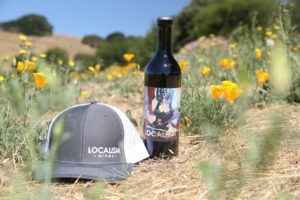
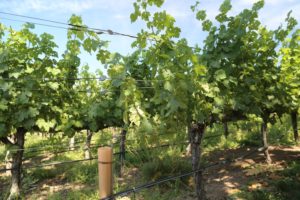
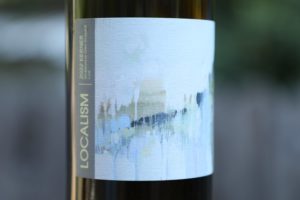 LOCALISM WINES was founded in 2010 by two winemakers Ryan Knoth and Landon Donely. Landon is no longer involved and today Ryan and his wife Nicole oversee the operations of their tiny brand. LOCALISM is tribute to a lifestyle centered around the connections and the network that Ryan and Nicole have made locally in Napa Valley ranging from vineyard sites, wine suppliers and friends within the industry.
LOCALISM WINES was founded in 2010 by two winemakers Ryan Knoth and Landon Donely. Landon is no longer involved and today Ryan and his wife Nicole oversee the operations of their tiny brand. LOCALISM is tribute to a lifestyle centered around the connections and the network that Ryan and Nicole have made locally in Napa Valley ranging from vineyard sites, wine suppliers and friends within the industry.
Raised in Alameda (San Francisco Bay Area), Ryan is a graduate of California Polytechnic University-San Luis Obispo with a degree in Biological Sciences. Prior to winemaking, Ryan worked in biotech at a startup in San Diego. While wine tasting in Paso Robles, Ryan had a moment of clarity – and asked himself, “why can’t I enjoy this lifestyle”. He went back to school and finished a Post bachelor’s degree in Enology at California State University-Fresno.
After graduating, he took a harvest intern job in the Barossa Valley in Australia at Elderton Wines in 2010 – while there he was already planning his move to the Napa Valley. He moved to Napa and never left; after returning stateside he worked at St. Clement Vineyards, Staglin Family Vineyard, Gandona, and is currently winemaker at Sinegal Estate Winery.
Over the course of his winemaking career, Ryan has learned from top winemakers including Danielle Cyrot, Philippe Melka and Anthony Biagi. His own style of winemaking focuses on creating balanced food friendly wines – harvesting perhaps a bit earlier than today’s norm – ensuring good acidity, yet also flavor. In summary, harvesting for maturity but not for over ripeness. And during the winemaking as Ryan puts it, “not hiding behind the oak” – carefully adding oak to complement rather than overpowering the wines.
Through a friend who bought used wine barrels from several of the wineries that Ryan worked at over the years, he was introduced to a rare California planting of Kerner, a white variety growing at Mokelumne Glen Vineyards in Lodi. This is not the only unique variety planted here; remarkably, the Koth family grows more then 40 different grapes found in the vineyards of Austria and Germany. Kerner was created in 1929 by crossing the red variety Trollinger with Riesling and in 1969 began to be cultivated for commercial use. Today it grows in various parts of Germany including the Mosel wine region. According to the California Department of Food and Agriculture Statistics review from 2014-2015 (the latest report we could find that still shows the specific amounts of lesser planted varieties) there are only 7.6 acres of Kerner planted in the entire state.
Select Wines
Kerner
Whites
The 2022 LOCALISM Kerner Mokelumne Glen Vineyard in Lodi is medium gold in color; the youthful, energetic and minerally bouquet reveals aromas of honeysuckle, star jasmine, orange blossom, lemongrass, lime zest, honeydew melon, and freshly cut grass. The palate immediately elicits a ‘wow’, at least that is the generic adjective we said out loud while were tasting this wine. It is balanced, yet richly flavored and flows with a bright vein of acidity from the entry through to the brightly lit finish. And if there is any residual sugar here, the acidity balances it out in a most pleasant fashion. Its flavors include mandarin orange, pineapple, pineapple guava, not fully ripe lychee, green apple and passion fruit. The acidity is balanced, lively but never crosses into the territory of being tart or grassy. Halibut or freshly caught Dungeness crab please. This vintage in particular of the Localism Kerner is worth seeking out. Localism did not produce a 2023 Kerner due to problems with flooding in the Mokelumne Glen Vineyard.
The 2018 LOCALISM Kerner is straw colored in the glass; it offers very pretty aromatics, sweet, tropical and floral with aromas of honeysuckle, apricot and ripe peach. One might presume from the bouquet that this wine is going to be a dessert wine but not so. The palate is clean but with complexity – balanced and flavorful with flavors of stone fruits and a lingering note of tangerine. There is a very subtle hint of residual sugar to nicely complement the bright acidity. We love Rieslings for their versatility with foods – Kerner has just been added to our list of favorite white varieties. And it is certainly a very unique bottling from a Napa Valley based producer. The only Napa Valley winery we know that grows and bottles this variety is Silverado Vineyards.
Sauvignon Blanc
The 2017 Localism Napa Valley Sauvignon Blanc is 100% varietal of which 50% is Musqué clones. Ryan stirs the lees during its aging keeping a close eye on the aromatic development over time. The wine ages 8-10 months in a combination of once-used oak barrels and stainless-steel barrels. Offers aromas of citrus, dried straw, honeysuckle, and dessert spices. Shows a rounded texture across the palate – not heavy. This is not a green or grassy style Sauvignon Blanc – offers plenty of flavor along with decent acidity.
Falanghina
Falanghina is an Italian white variety from Compania (Amalfi Coast). We rarely come across this variety from Napa producers; a couple that have produced wines with at least some Falanghina include The Prisoner for their Saldo label, Tank Garage and The Terraces. Spottswoode Winery grows a few rows of this in one of their experimental blocks.
The 2023 LOCALISM Falanghina, Lost Slough Vineyard Clarksburg is medium straw in color; highly aromatic, this wine sings in a high octave with scents of lemon zest, beeswax including a light honeyed note, pear blossom, golden apples, passion fruit, yellow peach, white nectarine, pineapple and citrus blossom. And it offers some very light herbal undertones including mint and chamomile. Bright, lifted, lively and most importantly balanced, this wine tastes like tangerine, green apple, pear and a minerally/chalky character most noticeable on the finish. There is some phenolic grip at play here with a light but lingering dryness and subtle bitter character perhaps similar to a citrus peel or not fully ripe grapefruit. Because we taste so little of this, in a blind tasting we might guess its heritage to be either Sauvignon Blanc or Albariño. This wine screams for seafood – we will take seared scallops, shrimp ceviche, or any of a number of fresh small plates of sashimi. The alcohol is a refreshing 13.1%.
Reds
Pinot Noir
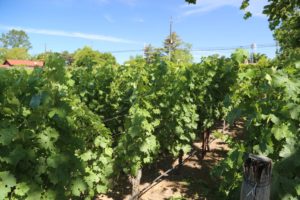
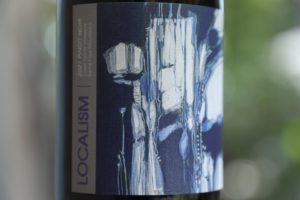 The 2024 LOCALISM Rosé of Pinot Noir, Carneros Sonoma County Los Catrines Vineyard is medium salmon in color; bright, lifted, minerally and with plenty of aromatic intensity, this rosé offers scents of blood orange, lemon peel, pink grapefruit, raspberries, wild strawberries, citrus blossom, lime, chalk and a light note of dried thyme. Balanced, but with some noticeable phenolic grip, on the palate there are flavors of raspberry, strawberry, watermelon jolly rancher, cranberry – but without the associated bitterness of this fruit, red currant and a minerally and red-fruited note on the finish. Its creamy and satin-like mouth feel is lifted high by its lively acidity. Lingers with a light note of dill. Thoroughly refreshing. Our first thought in terms of a food pairing is with crab cakes, letting the wines flavor and acidity temper the associated richness and crab cakes cooked with butter.
The 2024 LOCALISM Rosé of Pinot Noir, Carneros Sonoma County Los Catrines Vineyard is medium salmon in color; bright, lifted, minerally and with plenty of aromatic intensity, this rosé offers scents of blood orange, lemon peel, pink grapefruit, raspberries, wild strawberries, citrus blossom, lime, chalk and a light note of dried thyme. Balanced, but with some noticeable phenolic grip, on the palate there are flavors of raspberry, strawberry, watermelon jolly rancher, cranberry – but without the associated bitterness of this fruit, red currant and a minerally and red-fruited note on the finish. Its creamy and satin-like mouth feel is lifted high by its lively acidity. Lingers with a light note of dill. Thoroughly refreshing. Our first thought in terms of a food pairing is with crab cakes, letting the wines flavor and acidity temper the associated richness and crab cakes cooked with butter.
The 2021 LOCALISM Pinot Noir, Coast Grade Vineyard, Santa Cruz Mountains is sourced from a site at 1,300 feet in elevation merely 3 miles east as the crow fly’s from the cold waters of the Pacific Ocean. This wine is pale ruby in color; the playful bouquet offers aromas of strawberry, raspberry, currants, red licorice, rhubarb, mocha, vanilla, white pepper and cardamom. A vein of bright acidity runs the length of the palate, complemented by primarily red berry flavors including raspberry, currant, cranberry, cherry cola and licorice. Balanced and bright, the finish lingers with a note of dried tobacco leaf, white pepper and very lightly gravelly textured tannins. The finish is mouth watering and begs another sip; not many Napa Valley based wineries or brands produce wine from the Santa Cruz mountains and its a treat to try Pinot Noir from a region that is not as well known as some of California’s other prominent Pinot Noir locations. This wine would pair nicely with grilled duck or cured ham.
Cabernet Sauvignon
The focus of their tiny production Cabernet Sauvignon is from the Schwartz Family Vineyard in Coombsville. This slightly less than an acre vineyard is planted entirely to clone 7 Cabernet Sauvignon – the vines date from 1997. Perhaps more than some of Napa’s other sub appellations, Coombsville is known for its ‘backyard’ vineyards – or in this case, a front yard vineyard. Ryan discovered the property in 2009; the vineyard was being inadequately managed at that time. He took over the management of the vines and improved their overall health and vigor. He maintains a long-term lease on this vineyard.
Vineyard owner Ira Schwartz (from New York) was looking for a home in Napa Valley – as he puts it, at the time, he considered having “a vineyard a negative” – a perspective that certainly has since changed over the years. After taking a number of wine related courses at Napa Valley College he joined the Napa Valley College Foundation and serves on their board of directors and is an integral part of exciting developments happening at the school’s wine program which is the largest of its kind in the country – approximately 450 students. A three-phase plan has been formed for the Wine Education Center including construction a 6,000 square foot sensory classroom, converting the existing Trefethen classroom into a state-of-the-art laboratory and rebuild and renovate the current tasting room into a Wine Sales Training Facility.
Incidentally the vineyard that produces some of the Napa Valley’s highest priced wines is located just down the street from Ira’s vineyard.
The 2021 LOCALISM Cabernet Sauvignon; this wine is deep ruby with purplish tinges on the rim. The bouquet is berry fruited with scents of dark raspberry, blackberry, currant and red cherry. Lively and bright, the scents are focused primarily on its fruit rather than any overt barrel influences. And the palate somewhat mirrors the bouquet with flavors of blackberry, raspberry dark cherry and boysenberry. The texture stands out as an admirable character; one can feel the density of tannins but they are ripe, resolved, rounded and integrated. Lingers red fruited, lively and youthful three years post vintage at the time of our tasting.
The 2016 LOCALISM Cabernet Sauvignon is blended with a bit of Petit Verdot and Cabernet Franc from a warmer vineyard site in Calistoga. Ryan likes the complexities these other varietals add to the wine along with their added texture. This wine was aged in 25% new French oak with the remainder in once used barrels. It is dark garnet in color with layered aromatics including plum, violets, chocolate, dust, tobacco leaf, dried herbs and subtle darker spices. Very well balanced on the palate offers flavors of blueberry and blackberry anchored by finely shaped tannins, great acidity and a tobacco darker spice nuance on the finish.
Tastings, Vintner’s Collective
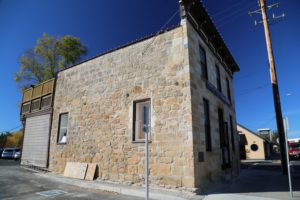
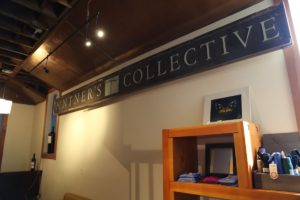 LOCALISM is a part of a coveted collection of vintners represented at Vintner’s Collective, the city of Napa’s oldest collective tasting room. Vintner’s Collective showcases wines from a select group of mostly Napa Valley based producers most of which do not have their own tasting rooms. And it’s not easy to have one’s wines represented here. Vintner’s Collective has an in-depth vetting process to make sure the wines match what their customers are interested in, including varieties, price points and wine styles.
LOCALISM is a part of a coveted collection of vintners represented at Vintner’s Collective, the city of Napa’s oldest collective tasting room. Vintner’s Collective showcases wines from a select group of mostly Napa Valley based producers most of which do not have their own tasting rooms. And it’s not easy to have one’s wines represented here. Vintner’s Collective has an in-depth vetting process to make sure the wines match what their customers are interested in, including varieties, price points and wine styles.
The tasting flights differ everyday which is certainly part of the appeal for visitors. Unless you are acutely tuned into the world of boutique Napa Valley producers, you probably will never have heard of any of the labels that are being poured, and that is not a bad thing. The wines represented are typically from producers who have a maximum annual production of 1,000 cases. A number of tasting flights are offered – geared towards all levels of wine interest and prior knowledge.
Walk-in customers are generally welcome if space allows but appointments can also be requested including for more private tastings hosted upstairs.
—
Each wine label is a unique piece of abstract art created by award winning Santa Rosa based artist, Mary Vaughn who maintains a fall and winter studio in the South A Street Art District or SOFA for short, a tiny arts community sandwiched between the 101 freeway and Santa Rosa Avenue spanning about two blocks along S. A Street. Her spring and summer studio is located in the tiny town of Hastings, Nebraska.
Ryan and Nicole own the original paintings used on their labels. Their discovery of Mary’s work was fortuitous – Mary’s mother used to tell her that her works would look good on wine labels – LOCALISM is the first brand that has used her work on wine labels. And each piece is named: Sauvignon Blanc: Undertow, Kerner: Eden, Pinot Noir: Blue Lagoon and the Cabernet Sauvignon: Breach.
The wines are made at a small winery where Ryan has full control of the winemaking. Production remains very small – usually 300 to 400 cases per year with distribution mostly in Northern California at select restaurants and retail wine shops. Locally the Kerner has been on the wine list at the French Laundry and other wines are available at Backroom Wines in the city of Napa for years as well as ACME Fine Wines in St. Helena. For more information and to join their mailing list, visit: www.localismwines.com

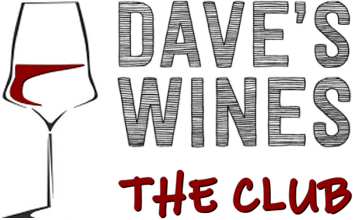




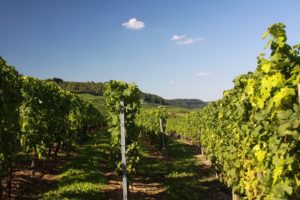
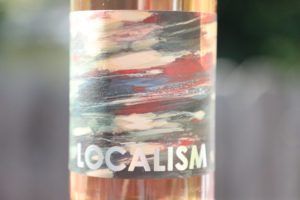
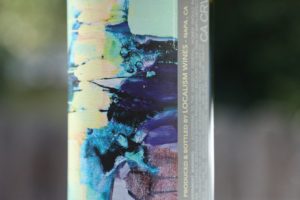
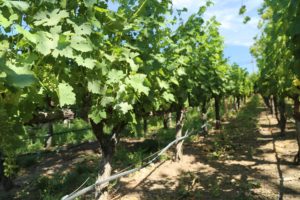

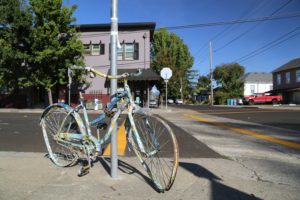
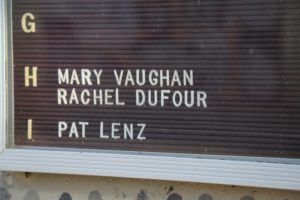
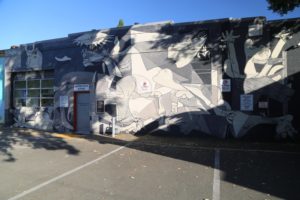

Leave a Reply